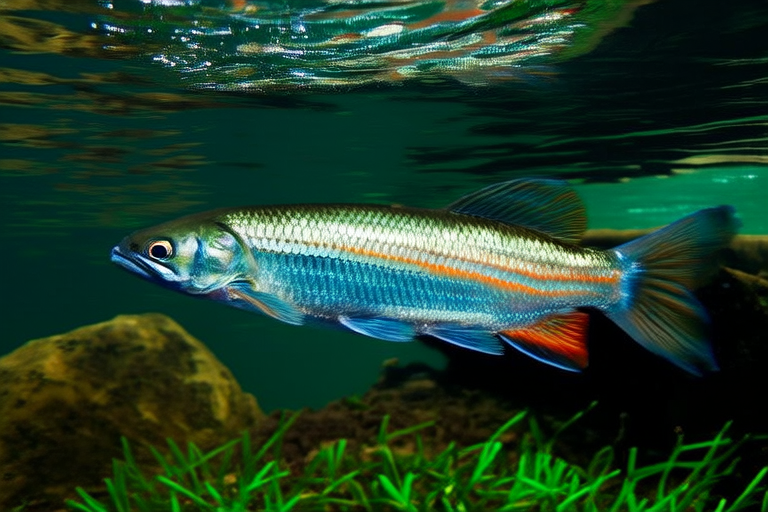Unleashing the Mystique of Rajah Cichlid: A Complete Care Guide
Introduction: The Enigmatic Rajah Cichlid
The Rajah Cichlid, scientifically known as Vicarius zenkeri, is a striking and captivating freshwater fish species native to the Congo River Basin in Africa. Renowned for its vibrant colors and unique patterns, this cichlid has long been a favorite among aquarium enthusiasts. Its name, derived from the word ‘rajah’ meaning ‘king,’ reflects its regal appearance and commanding presence within the aquatic environment. This guide aims to provide you with all the necessary information to successfully care for this majestic fish, ensuring it thrives in your home aquarium.
Tank Setup: Creating the Ideal Habitat
Setting up the right tank environment is crucial for the well-being of your Rajah Cichlid. These fish require a spacious tank that mimics their natural habitat. A minimum tank size of 75 gallons (300 liters) is recommended to accommodate their active nature and territorial behavior. Ensure the tank has plenty of hiding spots and caves made from rocks and driftwood, which will make your Rajah feel secure.
Substrate choice is also important; a sandy or fine gravel substrate works best. Avoid sharp-edged substrates that could harm the fish. Decorations should be sturdy and heavy enough to withstand the powerful swimming and digging behaviors of the Rajah Cichlid. Additionally, ensure the tank is equipped with efficient filtration and proper aeration to maintain clean and oxygen-rich water.
Water Conditions: Mimicking Their Natural Environment
Rajah Cichlids thrive in slightly acidic to neutral water conditions. The optimal pH range is between 6.5 and 7.5, with a temperature range of 75-82°F (24-28°C). Regular testing and maintenance of these parameters are essential for their health. Hardness levels should be moderate, around 5-12 dGH. Use a reliable water testing kit to monitor these factors and make adjustments as needed.
Adequate water flow and a robust filtration system are necessary to keep ammonia and nitrite levels at zero and nitrate levels below 20 ppm. Perform weekly water changes of about 20-30% to maintain water quality. This will help prevent the buildup of harmful substances and ensure your Rajah Cichlid remains healthy and vibrant.
Diet Requirements: Nourishing Your Rajah Cichlid
Feeding your Rajah Cichlid a balanced diet is key to its longevity and vitality. In the wild, they primarily feed on small crustaceans, insects, and plant matter. In captivity, a varied diet consisting of high-quality flake food, pellets, and frozen or live foods such as bloodworms, brine shrimp, and daphnia is recommended. It’s advisable to rotate these foods regularly to ensure a diverse nutrient intake.
Avoid overfeeding, as excess food can lead to water pollution and health issues. Feed your Rajah Cichlid twice daily, offering only what they can consume within a few minutes. Additionally, incorporating occasional treats like vegetables such as zucchini or spinach can provide necessary vitamins and minerals.
Behavior and Temperament: Understanding Your Fish
Rajah Cichlids are known for their bold and assertive personalities. They are highly territorial, especially during breeding periods, and may become aggressive towards other fish, particularly those of the same species. To minimize aggression, it’s best to house them with similarly sized and compatible species. Providing ample space and hiding spots can also help reduce stress and conflict.
Despite their territorial nature, Rajah Cichlids can exhibit fascinating behaviors. They are known for their intricate courtship displays and nest-building activities. Observing these behaviors can be both educational and entertaining for aquarium owners. By understanding and respecting their natural tendencies, you can create a harmonious and stimulating environment for your Rajah Cichlid.
Breeding Habits: Fostering the Next Generation
Breeding Rajah Cichlids can be a rewarding experience, but it requires careful planning and attention to detail. Begin by setting up a separate breeding tank with similar water conditions to the main tank. Introduce a mature male and female pair, ensuring they have adequate hiding spots and spawning sites.
During breeding, the pair will typically excavate a pit in the substrate and lay eggs there. Both parents take turns guarding the eggs and fanning them with their fins to ensure proper oxygenation. Once hatched, the fry should be fed infusoria or finely ground flake food. As they grow, gradually introduce larger foods. Be prepared for potential cannibalism, so separating the fry into different tanks may be necessary.
Common Health Issues: Keeping Your Rajah Cichlid Healthy
Like any fish, Rajah Cichlids are susceptible to certain health issues. Common ailments include fin rot, ich, and swim bladder disorders. Fin rot is characterized by frayed or discolored fins and can be treated with antibiotics or anti-fungal medications. Ich, a parasitic infection, presents as white spots on the body and can be managed with copper-based treatments. Swim bladder disorders often result from overfeeding or poor water quality and may require dietary adjustments and improved tank maintenance.
Regular observation and prompt action when signs of illness appear are crucial. Quarantine new additions to the tank to prevent the spread of diseases. Maintaining pristine water conditions and providing a balanced diet can significantly reduce the risk of health problems.
Maintaining a Healthy Environment: Tips for Success
To ensure your Rajah Cichlid remains healthy and happy, regular maintenance is essential. This includes performing routine water tests and making necessary adjustments to water parameters. Keep the tank clean by removing uneaten food and debris promptly. Monitor the behavior of your fish for any signs of stress or disease.
Building a strong bond with your Rajah Cichlid can enhance your enjoyment of keeping them. Spend time observing their daily activities and interactions. Familiarize yourself with their feeding preferences and response to stimuli. By creating a nurturing and enriching environment, you can foster a deep connection with these captivating creatures.
